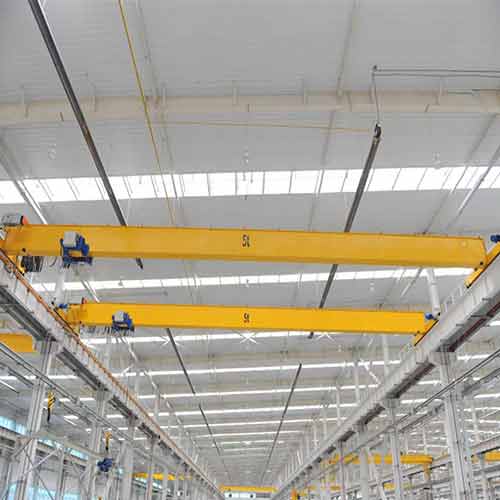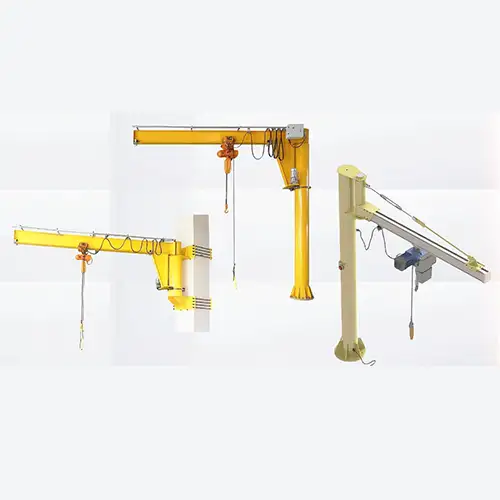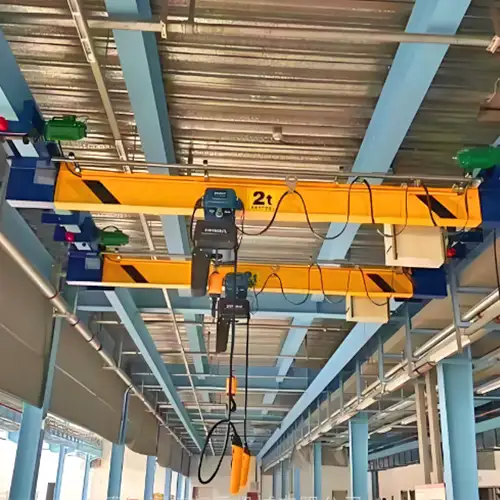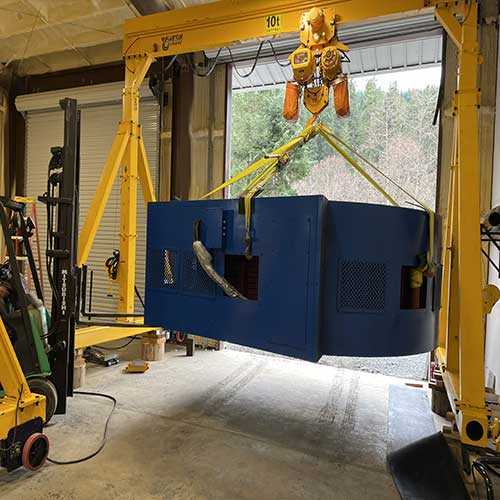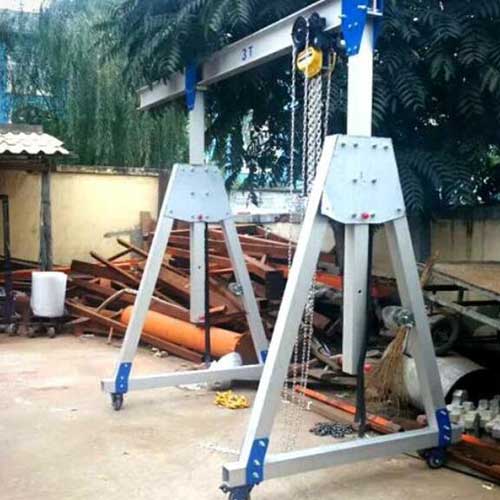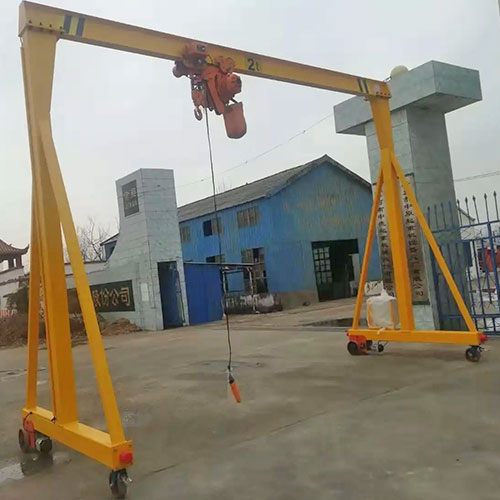Small Bridge Crane & Small Overhead Crane & Custom Crane System
Small overhead crane & small bridge crane for sale. All types of small overhead crane, small gantry crane & small jib crane systems for your selection.
Category: Small Crane
Your Trusted Overhead Small Crane Manufacturer & Supplier
Small Overhead Crane for Sale, Cost-effective Small Bridge Crane
All Types of Small Cranes Designs & Configurations for Smart Selection
Navigating the World of Small Cranes: A Comprehensive Guide for Smart Selection
In the dynamic landscape of industries that demand precision, mobility, and efficiency, small cranes emerge as unsung heroes. From bustling construction sites to intricate workshops, their versatile capabilities make them indispensable for a myriad of lifting and maneuvering tasks. This comprehensive guide is your compass in the world of small cranes, meticulously crafted to empower you with the knowledge required for astute decisions when selecting the perfect crane for your unique needs. Let's embark on a journey through various types, applications, and key considerations, with the ultimate goal of guiding you toward cost-effective choices aligned seamlessly with your specific requirements.
Small Overhead Crane Systems, Efficient Lifting Solutions for Industrial Precision
Small overhead crane systems are stalwarts in the industrial landscape, providing efficient lifting solutions that maximize precision and productivity. Mounted on overhead runway structures, these cranes are adept at navigating large manufacturing spaces, warehouses, and production facilities.
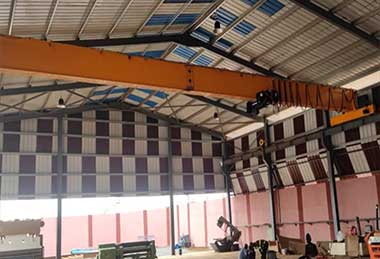
Small Overhead Crane with Top Running Single Girder Design
Features:
- Single Girder: Utilizes a single beam along the top of the crane for load support and movement.
- Top Running: The crane travels along tracks mounted at the top of the building structure.
- Compact Design: Efficiently utilizes space, ideal for facilities with limited headroom.
Benefits:
- Cost-Efficiency: Single girder design typically offers cost advantages in both initial investment and maintenance.
- Versatility: Suitable for various lifting tasks due to its adaptable design.
- Optimized Use of Space: Utilizes vertical space efficiently without requiring additional floor space.
Applications:
- Warehousing: Ideal for lifting and moving loads within warehouse facilities.
- Manufacturing: Suitable for assembly lines, material handling, and heavy equipment maintenance in manufacturing settings.
- Maintenance Work: Used for lifting machinery or equipment during maintenance and repair tasks.
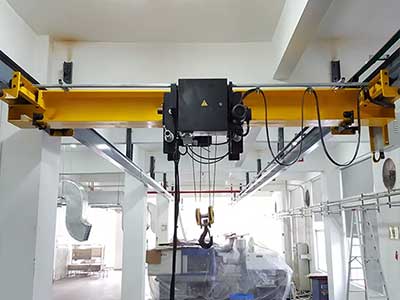
Small Overhead Crane with Ceiling Mounted Crane Design
Features:
- Mounted on Ceiling: Installed directly on the ceiling, maximizing floor space.
- Compact and Space-Saving: Ideal for facilities with minimal available space.
- Customizable Configuration: Can be customized based on specific lifting needs.
Benefits:
- Floor Space Optimization: Leaves the entire floor area free for operations or other machinery.
- Improved Safety: Reduces the risk of obstacles or obstructions on the ground.
- Enhanced Efficiency: Directly positions the crane closer to the work area, reducing load transfer distance.
Applications:
- Workstations: Used for localized lifting tasks in specific workstations or production areas.
- Clean Room Environments: Suitable for environments requiring strict cleanliness where floor-based equipment might not be suitable.
- Limited Space Facilities: Ideal for facilities with limited ground space.

Small Bridge Crane with Freestanding Crane Design
Features:
- Freestanding Structure: The crane stands independently without requiring support from the building structure.
- Bridge Configuration: Utilizes a bridge-like structure for lifting and movement.
- Versatile Design: Allows movement across a broader area.
Benefits:
- Flexibility: Offers more mobility and freedom of movement compared to ceiling-mounted or overhead cranes.
- No Structural Attachments: Eliminates the need for building reinforcement or structural modifications.
- Higher Capacity: Can handle heavier loads due to the sturdy freestanding design.
Applications:
- Outdoor Operations: Suitable for outdoor workspaces or areas where building-mounted cranes are not feasible.
- Warehouse Handling: Used for heavy-duty lifting tasks in warehouses and logistics facilities.
- Loading Docks: Ideal for loading and unloading operations in various industries.

Small Bridge Crane with Low Headroom Crane Design
Features:
- Low Headroom Configuration: Specifically designed for facilities with limited overhead space.
- Compact Design: Suitable for applications where vertical space is restricted.
- Minimal Maintenance: Requires less maintenance due to its simplified design.
Benefits:
- Space Optimization: Maximizes available headroom without compromising lifting capacity.
- Adaptability: Ideal for retrofitting in existing facilities with constrained overhead space.
- Reduced Installation Costs: Eliminates the need for major structural modifications in buildings.
Applications:
- Workshops: Suited for small workshops or areas with low ceilings.
- Manufacturing Plants: Used in areas where existing infrastructure limits headroom for conventional cranes.
- Tool and Die Handling: Efficiently handles tool and die sets in manufacturing or machining environments.

Small Bridge Crane with Explosion-Proof Crane Design
Features:
- Explosion-Proof Components: Incorporates specialized features and materials to prevent sparks or combustion.
- Robust Construction: Designed to withstand hazardous or potentially explosive environments.
- Safety Measures: Includes safeguards against electrical hazards and ignition sources.
Benefits:
- Enhanced Safety: Reduces the risk of ignition or explosion in volatile environments.
- Compliance with Regulations: Meets safety standards and regulations for hazardous work environments.
- Reliable Performance: Ensures continuous operation in environments prone to explosions or fire hazards.
Applications:
- Chemical Plants: Ideal for handling materials or equipment in areas susceptible to chemical exposure.
- Oil and Gas Industry: Used in facilities where flammable substances are present.
- Pharmaceuticals or Hazardous Materials: Suitable for environments where flammable or hazardous materials are handled.
Understanding the specific features, benefits, and applications of each small overhead or bridge crane design allows for informed decisions when selecting the most suitable crane for a particular working environment or lifting task.
Key Features:
- Overhead Runway Structure: Small overhead cranes utilize an elevated runway system, optimizing floor space for other operations.
- Versatility: Ideal for various industrial applications, including material handling, assembly lines, and heavy equipment maintenance.
- Precision Control: Equipped with advanced control systems, these cranes offer precise maneuverability, ensuring accuracy in lifting and placing heavy loads.
Applications:
- Manufacturing Facilities: Small overhead cranes streamline production processes by efficiently moving materials and components within expansive manufacturing spaces.
- Warehouses: Optimizing vertical space, these cranes facilitate the organized storage and retrieval of goods in warehouses.
- Maintenance Work: Ideal for tasks that require lifting and positioning heavy machinery or equipment for maintenance and repair.
Small Telescopic Crane
The small telescopic crane introduces a new dimension of versatility to lifting operations. Characterized by an extendable arm, these cranes are designed for tasks that require increased reach and adaptability in challenging environments.
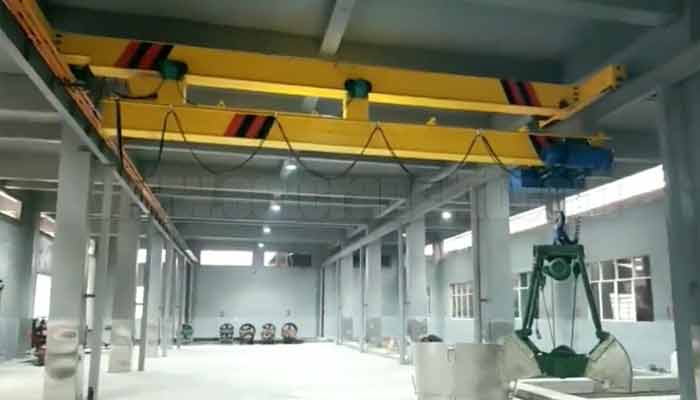
Small Telescopic Crane with Top Running Crane Design
Features:
- Telescopic Arm: Incorporates an extendable arm for variable reach.
- Top Running Design: Travels along top-mounted tracks for movement.
- Adaptability: Adjusts the telescopic arm for different reach requirements.
Benefits:
- Variable Reach: Offers extended reach capabilities for lifting at varying distances.
- Top Running System: Utilizes overhead space efficiently without floor obstruction.
- Flexibility: Suitable for diverse lifting tasks with adjustable reach.
Applications:
- Construction: Ideal for lifting materials to various heights on construction sites.
- Warehousing: Efficiently handles goods across different storage levels in warehouses.
- Maintenance: Facilitates lifting and placement of equipment during maintenance tasks.
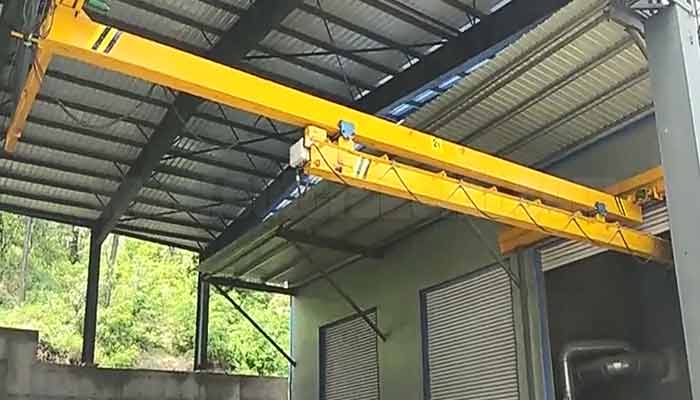
Small Telescopic Crane with Underslung Crane Design
Features:
- Telescopic Arm: Equipped with an extendable arm for increased reach.
- Underslung Design: Mounted underneath a fixed structure or beam.
- Compact Build: Space-saving design suitable for limited overhead space.
Benefits:
- Low Headroom Requirement: Perfect for spaces with limited vertical clearance.
- Enhanced Maneuverability: Allows for precise lifting in confined areas.
- Optimized Space Usage: Leaves floor space clear for other operations.
Applications:
- Workshops: Suited for lifting tasks within workshops with restricted headroom.
- Manufacturing: Efficiently handles materials in areas with limited overhead space.
- Tool and Die Handling: Precisely moves tool and die sets in machining environments.
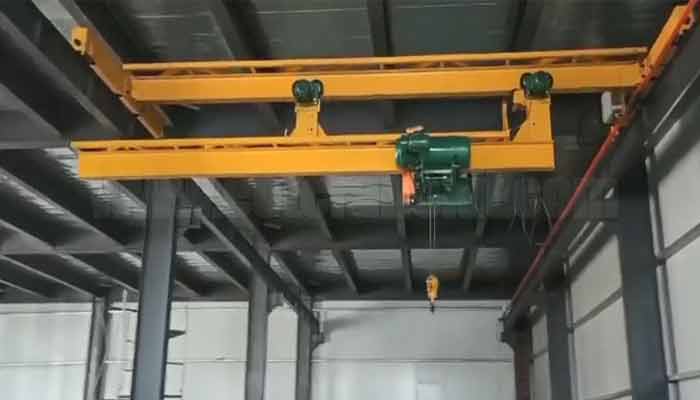
Small Telescopic Crane with Freestanding Crane Design
Features:
- Telescopic Arm: Features an extendable arm for variable reach.
- Freestanding Build: Independent structure, not reliant on building support.
- Bridge Configuration: Utilizes a bridge-like structure for lifting and movement.
Benefits:
- Enhanced Mobility: Offers greater movement and flexibility compared to fixed cranes.
- No Building Attachment: Eliminates the need for structural support.
- Adaptable Reach: Allows for variable reach based on lifting requirements.
Applications:
- Outdoor Operations: Suitable for outdoor lifting tasks with no fixed infrastructure.
- Warehousing and Logistics: Offers mobility in handling goods across a broader area.
- Loading Docks: Facilitates loading and unloading in various industries.
Key Features:
- Extendable Arm: The telescopic feature allows the crane's arm to extend and retract, providing variable reach for lifting loads at different distances.
- Adaptability: Suited for tasks where a fixed-length arm might be limiting, such as construction sites with varying elevations.
- Compact Design: Despite their extended reach capability, small telescopic cranes maintain a compact design, making them suitable for confined spaces.
Applications:
- Construction Sites: Small telescopic cranes are invaluable for lifting materials to different heights during construction projects.
- Roofing and Building Maintenance: Ideal for tasks that require reaching elevated areas, such as roofing or maintenance work on tall structures.
- Landscaping Projects: Facilitates the lifting and placement of heavy materials in landscaping and outdoor projects.
As we continue our exploration of small crane types, stay tuned for more insights into their diverse applications and how each design caters to specific lifting needs.
Each type of small telescopic crane offers distinct features and advantages, making them suitable for different applications and operational settings. Understanding these features aids in selecting the appropriate crane based on specific lifting needs, space limitations, and maneuverability requirements.
Small Gantry Crane & Small Gantry System
Small gantry cranes are versatile lifting devices renowned for their mobility and flexibility across various work environments. These cranes feature a horizontal beam supported by vertical legs, creating a free-standing structure that allows for easy movement and positioning. Their design enables them to efficiently lift and transport loads within a specific area, making them invaluable for numerous applications.
Characterized by their portability and adaptability, small gantry cranes offer the advantage of being easily maneuvered and positioned as needed. Equipped with wheels or casters on their base, these cranes can be swiftly moved to different locations within a workspace, eliminating the need for a fixed installation. Their ability to handle various load capacities makes them suitable for lifting both lighter and heavier materials.
Small gantry cranes find widespread use in workshops, manufacturing facilities, construction sites, and warehouses. They excel in tasks requiring mobile and efficient lifting solutions, such as loading and unloading materials, transporting heavy items, or assisting in assembly processes. Their flexibility in navigating around obstacles and through confined spaces makes them indispensable for tasks where fixed cranes may be impractical.
These cranes come in different designs, including adjustable height models, allowing for customization based on specific lifting needs. Their ease of assembly and disassembly facilitates quick setup and usage, enhancing productivity while minimizing downtime. Small gantry cranes provide a safe and reliable means of lifting and handling materials, offering convenience and practicality in various industrial and commercial settings.
Dive into the world of small gantry cranes, including robust steel options and lightweight aluminum gantry cranes.
Small gantry cranes offer a diverse range of options, from robust steel structures to lightweight aluminum models, each designed to cater to specific lifting needs in various work environments.
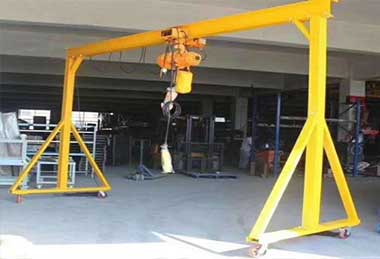
Features:
Robust steel gantry cranes are known for their durability and strength, making them ideal for handling heavier loads. Constructed from sturdy steel materials, these cranes offer stability and reliability in lifting operations.
Benefits:
- High Load Capacity: Capable of lifting heavier materials and equipment with ease.
- Sturdy Construction: Provides stability and support for substantial loads.
- Durability: Resistant to wear and tear, ensuring long-term use in demanding environments.
Applications:
- Industrial Settings: Ideal for manufacturing, construction, and heavy industry where lifting heavier loads is frequent.
- Workshops and Warehouses: Suitable for moving large equipment or materials within confined spaces.

Lightweight Aluminum Gantry Cranes:
Features:
Aluminum gantry cranes are designed for easy maneuverability and transportability. They are significantly lighter than their steel counterparts, offering convenience in handling and setup.
Benefits:
- Portability: Lightweight construction enables easy transportation and quick assembly.
- Corrosion Resistance: Aluminum's natural properties make these cranes resistant to corrosion.
- Versatility: Suitable for various applications due to their adaptability and ease of movement.
Applications:
- Versatile Use: Ideal for workshops, events, or settings requiring frequent crane relocation.
- Maintenance Tasks: Perfect for light to moderate lifting needs in maintenance or repair operations.
Both steel and aluminum gantry cranes offer distinct advantages, catering to different lifting requirements. The choice between these types depends on factors such as load capacity, durability, portability needs, and the specific work environment. The robustness of steel or the lightweight convenience of aluminum provides users with options that suit their operational demands, ensuring efficient and effective lifting solutions across diverse industries.

Small Gantry Crane with Fixed Height:
Features:
- Fixed-height gantry cranes have a static vertical clearance, meaning the height between the ground and the beam remains constant.
- Typically designed for specific applications where consistent lifting heights are required.
Benefits:
- Stability: Offers a stable lifting platform with a set clearance.
- Simplified Design: Easier to manufacture and maintain due to its fixed structure.
- Applications: - Specific Load Requirements: Ideal for tasks where lifting requirements remain constant.
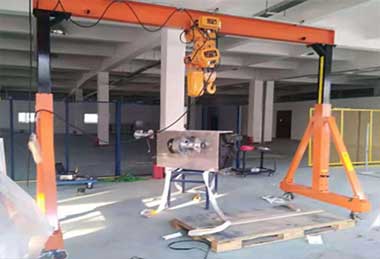
Small Gantry Crane with Adjustable Span:
Features:
- Gantry cranes with adjustable spans allow for alterations in the distance between the two vertical legs supporting the horizontal beam.
- Adjustability in span width offers versatility in accommodating different load widths.
Benefits:
- Customization: Allows for the adaptation of the crane's width to suit specific load sizes or workspace limitations.
- Flexibility: Enables efficient handling of various-sized materials by adjusting the span width.
- Applications: - Variable Load Sizes: Beneficial in scenarios where materials have different widths or when operating within confined spaces that require adjustable spans.
Each small gantry crane design offers unique advantages tailored to specific lifting needs and operational environments. The choice between fixed or adjustable height, as well as adjustable span, depends on factors such as load variability, workspace constraints, and the flexibility required in lifting applications.
Small Gantry Lift, Hoist, and Crane for Sale
Features:
- Diverse Lifting Solutions: Offer a variety of lifting mechanisms for different load capacities.
- Adaptability: Can be customized according to specific lifting requirements.
- Availability for Sale: Available for purchase, providing options for buyers seeking specific lifting equipment.
Considerations for Purchase:
- Load Capacity: Ensure the chosen lift, hoist, or crane meets the required load specifications.
- Budget Consideration: Evaluate pricing against features and performance to make a cost-effective choice.
- Supplier Reliability: Opt for reputable suppliers offering quality products and after-sales support.
Whether it's the robust steel gantry cranes suited for heavy-duty industrial applications or the lightweight and versatile aluminum gantry cranes, the availability of various lifting solutions in the small gantry category provides options for diverse operational needs. Buyers seeking small gantry lifts, hoists, or cranes for sale should consider factors such as load capacity, budget, and supplier reliability for an informed and effective purchase decision.
Small Jib Crane
Small jib cranes are compact, versatile lifting devices designed for handling relatively light loads within confined spaces. They are characterized by a horizontal jib or boom that can rotate around a vertical axis, offering flexibility and precision in material handling tasks. Here's an overview of small jib cranes:

Small Jib Crane with Wall-Mounted Design
Features:
- Wall-Mounted: Fixed directly onto a wall or vertical surface, saving floor space.
- Swivel Arm: Equipped with a swiveling jib arm for rotational movement.
- Space-Efficient: Ideal for small workshops or areas with limited floor space.
Benefits:
- Space Optimization: Maximizes floor space by utilizing vertical surfaces.
- 60-Degree Rotation: Provides a broad range of motion for lifting and positioning.
- Clear Work Areas: Leaves floor areas unobstructed for other operations.
Applications:
- Workstations: Perfect for small manufacturing cells or workstations.
- Production Lines: Assists in material handling in assembly or production lines.
- Maintenance Areas: Aids in positioning tools or equipment during maintenance tasks.

Small Jib Crane with Floor-Mounted Design
Features:
- Floor-Mounted: Installed directly onto the floor, offering stability and support.
- Rotating Arm: Features a jib arm that rotates horizontally for flexible movement.
- Sturdy Base: Provides stability for lifting and positioning loads.
Benefits:
- Enhanced Stability: Floor-mounted design offers greater stability for heavier loads.
- Easy Installation: Doesn't require structural modifications and is easier to install.
- Versatile Usage: Adaptable to various industries and environments.
Applications:
- Warehousing: Efficiently handles materials in warehouse storage or loading areas.
- Manufacturing: Aids in production lines for moving components or products.
- Heavy Maintenance: Useful for lifting heavy tools or machinery in maintenance areas.

Small Jib Crane with Portable Jib Design - 500kg portable jib crane for sale Kuwait for reference
Features:
- Portable: Designed for mobility, can be moved to different locations.
- Compact Size: Smaller in size compared to fixed jib cranes.
- Adaptable Mounting: Can be temporarily mounted onto a stable surface.
Benefits:
- Mobility: Offers flexibility in lifting tasks across various locations.
- Quick Set-Up: Easily assembled and disassembled for rapid deployment.
- Versatile Use: Suitable for temporary or occasional lifting needs.
Applications:
- Construction Sites: Assists in lifting materials or tools at different locations.
- Field Work: Useful for lifting tasks in outdoor or remote environments.
- Temporary Operations: Ideal for short-term projects requiring lifting capabilities.
Features of Small Jib Cranes:
- Jib Arm: These cranes feature a horizontal jib arm that can rotate, providing a wide range of motion for lifting and positioning loads.
- Compact Size: Designed to occupy minimal floor space, making them suitable for small workshops, production lines, and other limited-space environments.
- Mounting Options: Can be wall-mounted, pillar-mounted, or freestanding, providing flexibility in installation based on space availability and structural requirements.
- Variety of Configurations: Available in different configurations such as wall-mounted, floor-mounted, and articulating or articulated jibs, catering to various operational needs.
- Ease of Use: Simple to operate and maneuver, enabling precise and controlled material handling.
- Light to Moderate Load Capacity: Typically suited for lifting loads ranging from a few hundred pounds to a couple of tons, depending on the specific model.
Benefits of Small Jib Cranes:
- Space Efficiency: Ideal for workplaces with limited space, utilizing vertical space effectively while keeping the floor area clear.
- Enhanced Maneuverability: The rotational jib arm allows for precise positioning of loads, facilitating efficient and controlled lifting.
- Versatility: Suitable for various industries, including manufacturing, workshops, warehouses, and assembly lines, adapting to different lifting requirements.
- Cost-Effective: Generally more affordable than larger cranes, making them an economical choice for smaller-scale lifting needs.
- Ease of Installation: Installation is often straightforward, requiring minimal modifications to existing structures.
Applications of Small Jib Cranes:
- Workshops and Manufacturing: Used for lifting components, tools, and materials in assembly or production lines.
- Warehousing: Facilitates loading and unloading of goods onto shelves or conveyor systems.
- Maintenance Tasks: Assists in machinery maintenance, aiding in the positioning of parts and equipment.
- Construction Sites: Provides support for lifting light loads in construction projects.
- Retail and Small Businesses: Helps in handling goods and products in retail spaces or smaller-scale business operations.
Small jib cranes offer an efficient, space-saving, and cost-effective solution for light to moderate lifting tasks within confined areas. Their flexibility, ease of use, and adaptability to various industries make them an essential component in enhancing material handling processes in smaller-scale operations.
Each type of small jib crane presents unique features, benefits, and applications, allowing for tailored solutions based on specific spatial, operational, or mobility requirements within various industries and work environments.
Small Crane Types Based on Crane Traveling and Mounting
Portable Small Cranes vs. Small Crane on Tracks
Understand distinctions between portable small cranes and those mounted on tracks, exploring options like small portable jib cranes, small portable gantry cranes, and small portable crane lifts.
Portable Small Cranes:
Portable small cranes are versatile and compact lifting solutions designed for mobility and flexibility across diverse work settings. These cranes are engineered to be easily transportable and adaptable, providing efficient lifting capabilities without the need for a fixed installation. Their portability allows for swift deployment and usage in various locations, making them ideal for applications where mobility and quick setup are essential.
Characterized by their lightweight and compact designs, portable small cranes offer the convenience of being moved from one job site to another with ease. They are engineered to handle a range of lifting tasks within confined spaces or locations where a fixed crane might be impractical or impossible to install. The adaptability of these cranes enables them to efficiently navigate through narrow spaces or areas with restricted access.
These cranes come in different types, such as portable jib cranes and portable gantry cranes, each catering to specific lifting needs. Portable jib cranes feature a rotating arm, providing a pivotal point for lifting and moving loads within a limited radius. On the other hand, portable gantry cranes are equipped with wheels and adjustable legs, allowing them to be easily positioned and providing stable support for heavier loads.

Small Portable Jib Cranes:
- Utilizes a jib arm that can be easily moved and positioned to lift loads within a limited radius.
- Ideal for workshops, construction sites, or areas requiring frequent material handling.

Small Portable Gantry Cranes:
- Equipped with a mobile frame and adjustable legs for stability, allowing lifting of heavier loads.
- Commonly used in warehouses, loading docks, or manufacturing plants.
Features:
- Mobility: Designed for easy movement and transportability across different job sites or work areas.
- Compact Design: Generally smaller in size and weight, facilitating portability.
- Flexible Mounting: Can be set up quickly and used in various locations without fixed installation.
Their versatility finds application in various industries, including workshops, construction sites, warehouses, and maintenance operations. Portable small cranes facilitate the lifting and positioning of materials or equipment in areas where a permanent crane installation might not be feasible, offering a convenient and practical solution for lifting tasks on the go.
In essence, portable small cranes offer a combination of mobility, adaptability, and efficiency in material handling. Their portable nature makes them a valuable asset in industries that require versatile lifting solutions in different locations or confined spaces.
Small Crane on Tracks:
Small cranes on tracks represent a specialized category of lifting equipment designed for precision, stability, and controlled movement within specific pathways or predetermined routes. Mounted on tracks or rails, these cranes utilize wheels or trolleys to navigate, ensuring smooth and precise transport of loads along a predefined path.
Their track-mounted design ensures accuracy and reliability in movement, allowing these cranes to follow predefined paths without deviation. This precision is particularly beneficial in industries requiring exact positioning and controlled transport of materials or goods.

Rail-Travelling Small Bridge Crane:
Features:
- Design: Consists of a bridge beam that travels along elevated runways or rails.
- Movement: Runs on parallel elevated tracks or runways.
- Lifting Capacity: Capable of handling moderate to heavy loads.
- Precision: Offers precise horizontal movement along the rails.
- Stability: Provides stability and support for heavier loads due to the rail-mounted structure.
Applications:
- Manufacturing: Used in production lines for assembly and material handling.
- Warehousing: Facilitates movement and storage within warehouses.
- Heavy Industry: Suitable for heavy-duty lifting in industrial settings.

Rail-Travelling Small Gantry Crane:
Features:
- Design: Equipped with wheels or casters for movement along rails on the ground.
- Versatility: Combines the benefits of a gantry structure with rail mobility.
- Lifting Capacity: Handles moderate to heavy loads efficiently.
- Flexibility: Provides the ability to move and position loads within a defined area.
- Stability: Offers stability while accommodating heavier loads.
Applications:
- Construction Sites: Assists in lifting and positioning materials on construction sites.
- Loading Docks: Suitable for loading/unloading tasks in shipping and logistics.
- Workshops: Facilitates material handling in workshops or production areas.
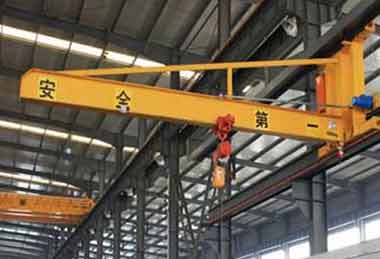
Rail-Travelling Small Jib Crane:
Features:
- Design: Incorporates a jib arm mounted on a carriage that moves along rails.
- Maneuverability: Allows rotational movement and lateral travel along the rails.
- Lifting Capacity: Typically handles lighter to moderate loads.
- Flexibility: Offers versatility in lifting and positioning within a specific radius.
- Space Utilization: Suitable for confined spaces due to its design.
Applications:
- Workstations: Assists in material handling within specific work areas.
- Manufacturing Cells: Aids in assembly or loading tasks in manufacturing cells.
- Maintenance Tasks: Supports lifting and positioning during maintenance operations.
Features:
- Fixed Track System: Operates along a set track or rail for movement.
- Dedicated Path: Follows a specific route or path determined by the track setup.
- Stability: Generally designed for consistent and controlled movement along the tracks.
Benefits:
- Precise Movement: Offers consistent and controlled movement along the designated track.
- Heavy Load Handling: Suitable for lifting heavier loads within its operational limits.
- Safety: Provides a predetermined path, reducing the risk of collision or accidents.
These cranes find application across diverse industries, including manufacturing, logistics, construction, and warehousing. They excel in tasks demanding consistent and controlled movement of heavy or bulky loads along a fixed route, providing reliable lifting solutions in various work environments.
With varying load capacities, from lighter to heavier materials, these cranes boast stability and efficiency in handling diverse materials. Their adaptability to different terrains, both indoors within manufacturing plants and warehouses, as well as outdoors at construction sites or transportation hubs, makes them versatile assets in material handling operations.
In essence, small cranes on tracks offer dependable, precise, and stable material handling and lifting capabilities, making them indispensable for industries seeking controlled and reliable lifting solutions for various operational needs.
These rail-travelling small cranes provide specific advantages based on their design, movement capabilities, lifting capacity, stability, and applications across various industries, catering to specific lifting needs within different work environments.
Portable small cranes and those mounted on tracks serve distinct purposes based on mobility, versatility, and the nature of the track or mobility system. Portable cranes offer flexibility and adaptability across various locations, while track-mounted cranes provide controlled movement along a predetermined path, catering to specific operational requirements within different industries and job environments.
Crane Applications of Small Cranes
Small Crane Lifting Equipment for Industrial Use vs. Home Use
Small Industrial Crane:
Small industrial cranes are specialized lifting equipment designed to meet the demands of industrial settings. These cranes are engineered to handle heavy loads and perform robustly in challenging environments typical of manufacturing facilities, construction sites, and warehouses. They ensure efficient material handling, contributing to streamlined industrial operations.
Features:
- Heavy-Duty Performance: Engineered for high load capacities and rigorous operations typical in industrial environments.
- Robust Design: Constructed with durable materials, ensuring resilience against demanding tasks.
- Safety Measures: Equipped with safety features and mechanisms for secure and efficient lifting.
Applications:
- Manufacturing: Ideal for lifting heavy machinery, raw materials, or finished products on production floors.
- Construction Sites: Suitable for construction projects, lifting materials, and equipment to desired heights.
- Warehouses: Facilitates efficient material handling and stock movement in storage facilities.
Benefits:
- Increased Efficiency: Streamlines industrial operations by providing reliable and powerful lifting solutions.
- Versatility: Capable of handling diverse loads and tasks in dynamic industrial settings.
- Durability: Withstands the demanding conditions prevalent in industrial environments.

Small Crane for Home Use:
Small cranes designed for home use are compact lifting solutions tailored to fit residential spaces. These cranes aim to provide lifting assistance in domestic settings without occupying excessive space. They are user-friendly and cater to various tasks encountered in home projects or maintenance.
Features:
- Compact Design: Tailored to fit residential spaces without compromising functionality.
- User-Friendly: Designed for ease of use and user safety, accommodating non-professional operators.
- Space Efficiency: Compact size ensures minimal space occupation in home environments.
Applications:
- DIY Projects: Ideal for home improvement tasks, lifting heavy objects, or aiding in construction projects.
- Gardening and Landscaping: Assists in moving and placing landscaping materials or garden features.
- Vehicle Maintenance: Helps in lifting engines or parts during vehicle repairs in home garages.
Benefits:
- Accessibility: Provides homeowners access to lifting solutions for personal projects or domestic tasks.
- Convenience: Enables tasks that would otherwise be physically demanding or impossible without lifting assistance.
- Cost-Efficiency: Offers an affordable and compact alternative to larger industrial-grade cranes.
Understanding the distinct functionalities and applications of small cranes designed for industrial and home use is crucial in selecting the appropriate crane for specific operational needs. Industrial cranes prioritize power, durability, and heavy-duty performance, while home-use cranes emphasize compactness, user-friendliness, and versatility in domestic settings.
Small Indoor Crane vs. Small Yard Crane
Navigate through various indoor cranes, including workshop, shop overhead, shop bridge, shop gantry, and shop hoist cranes.
Small indoor cranes are a specialized category of lifting equipment meticulously designed to navigate and operate within confined indoor spaces. These cranes, available in various configurations such as workshop cranes, shop overhead cranes, shop bridge cranes, shop gantry cranes, and shop hoist cranes, are tailored to cater to diverse indoor lifting needs. Their paramount feature lies in their precision and maneuverability, allowing for controlled and accurate lifting operations within limited indoor environments.
These cranes are the unsung heroes of workshops, manufacturing facilities, and warehouses, providing invaluable support in handling tasks that require meticulous handling or precise positioning. Their versatile configurations allow for adaptability to different indoor settings, offering solutions for diverse lifting challenges encountered in industrial or commercial spaces. Whether it's assembly lines, production floors, or storage facilities, small indoor cranes ensure efficient material handling while optimizing the limited available space.
The compact design and tailored functionalities of small indoor cranes make them indispensable tools for tasks requiring controlled movements and precise handling of loads within confined indoor areas. Their capability to operate in constrained spaces without compromising on lifting efficiency makes them a cornerstone of productivity in indoor environments, aiding in streamlining operations, enhancing workflow, and contributing significantly to the overall efficiency of various industries.

Small Shop Crane:
A small shop crane is a compact lifting device designed for use within commercial or industrial shop settings. These cranes are tailored to provide lifting and handling solutions for moderate loads encountered in workshop environments.
Features:
- Compact Design: Fits into limited space within shop areas.
- Maneuverability: Allows for mobility within the shop floor for versatile lifting.
- Various Configurations: Available in different types such as gantry, overhead, or wall-mounted variants.
Applications:
- Material Handling: Lifting and transporting materials or equipment within shops.
- Maintenance Support: Aids in machinery maintenance or repairs.
- Tool Assistance: Helps in lifting heavy tools or components to workstations.
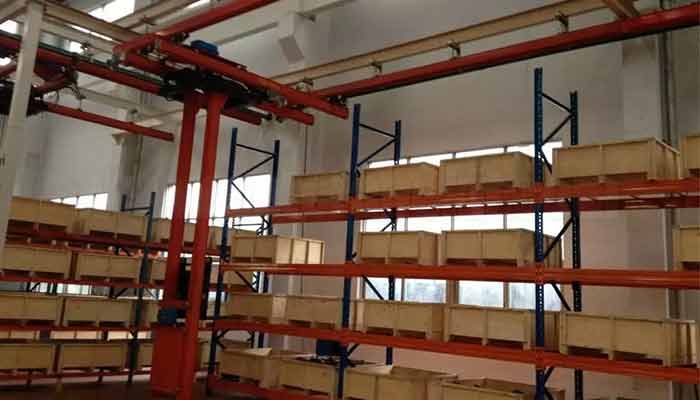
Small warehouse cranes are designed for lifting and handling tasks within warehouse settings. They are intended to assist in material movement, stock management, and handling operations in smaller-scale warehouse environments.
Features:
- Sturdy Construction: Built to withstand warehouse conditions.
- Efficient Load Handling: Capability to handle moderate to heavy loads.
- Versatile Configurations: Available in ceiling-mounted or freestanding options.
Applications:
- Stock Management: Assists in the organization and movement of goods within warehouses.
- Loading/Unloading: Aids in loading or unloading items onto storage racks or pallets.
- Inventory Handling: Facilitates efficient movement of inventory across the warehouse floor.

Small garage cranes are specialized lifting solutions designed for home garage or personal workshop use. They cater to various lifting needs encountered in DIY projects or vehicle maintenance tasks.
Features:
- Space Efficiency: Compact design suitable for home garage spaces.
- User-Friendly: Designed for ease of operation by non-professionals.
- Support for DIY Tasks: Aids in lifting engines, vehicle parts, or heavy tools during repairs or DIY projects.
Applications:
- Vehicle Maintenance: Assists in lifting engine blocks or heavy car parts during repairs.
- DIY Projects: Supports lifting and positioning heavy items in home-based projects.
- General Maintenance: Helps in handling heavy objects for household repairs.
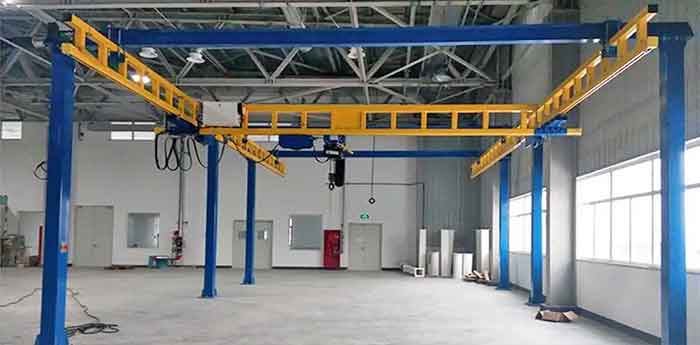
Small workstation cranes are designed for use in specific workstations within manufacturing or industrial settings. They facilitate precise lifting and handling tasks at dedicated workstations.
Features:
- Localized Lifting: Designed to cater to lifting needs at specific workstations.
- Precision Handling: Ensures accurate placement of loads at workstations.
- Configurable: Can be adapted to suit different workstation layouts.
Applications:
- Manufacturing Tasks: Aids in precise assembly or handling of components at specific workstations.
- Tool Support: Assists in lifting heavy tools or equipment to designated work areas.
- Customized Applications: Tailored to lifting requirements within individual workstations.
These various small indoor cranes - small shop cranes, warehouse cranes, garage cranes, and workstation cranes - cater to specific environments and lifting needs, offering tailored solutions within confined spaces and diverse operational settings.
Small Ceiling Crane, Wall Crane, Floor Crane
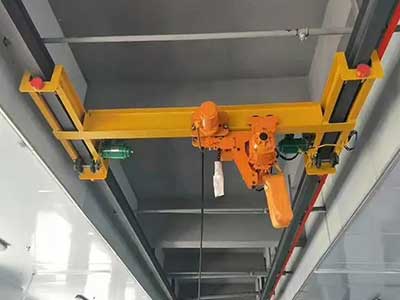
Small ceiling cranes are specifically engineered for applications where floor space is limited, utilizing the vertical space of the ceiling for lifting tasks. These cranes are mounted on the ceiling structure, optimizing overhead space for efficient lifting and movement.
Features:
- Ceiling-Mounted: Installed on the ceiling, maximizing floor space for other operations.
- Overhead Lifting: Facilitates vertical lifting and movement of loads within the designated area.
- Space Optimization: Ideal for applications where floor space is a constraint.
Applications:
- Assembly Lines: Aids in overhead lifting in manufacturing assembly lines.
- Storage Facilities: Facilitates lifting and movement in warehouse storage areas.
- Workstations: Assists in precise lifting tasks at specific workstations.

Small wall cranes are wall-mounted lifting devices suitable for applications with limited floor space. These cranes are fixed to the walls, providing efficient lifting capabilities while freeing up the floor area for other activities.
Features:
- Wall-Mounted: Mounted on walls to conserve floor space for other operations.
- Localized Lifting: Provides lifting support in specific areas without occupying floor space.
- Compact Design: Suitable for confined spaces where floor-based cranes are impractical.
Applications:
- Workshops: Assists in lifting within workshop spaces where floor space is limited.
- Manufacturing Cells: Facilitates lifting at individual manufacturing cells or workstations.
- Storage Areas: Supports lifting tasks in compact storage or inventory areas.
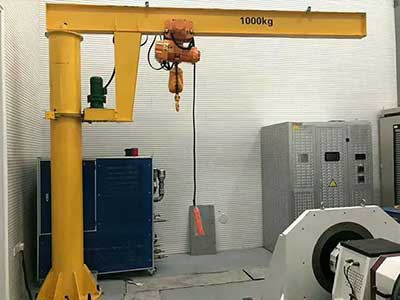
Small floor cranes are versatile lifting solutions designed to operate on the ground. These portable cranes offer flexibility and maneuverability in open spaces, allowing for varied lifting tasks.
Features:
- Ground-Based: Operates directly on the floor surface, offering stability and mobility.
- Versatile Handling: Suitable for diverse lifting tasks and load capacities.
- Mobility: Portable design for easy movement across different work areas.
Applications:
- Workshops and Garages: Assists in lifting heavy components or vehicles during repairs.
- Warehouses: Supports loading/unloading tasks in open warehouse spaces.
- Construction Sites: Aids in lifting materials or equipment at construction sites.
These different types of small indoor cranes - ceiling cranes, wall cranes, and floor cranes - offer distinct solutions for lifting tasks in spaces where specific mounting or spatial limitations require innovative lifting solutions.
Similarities:
- Lifting Functionality: All three cranes are designed for lifting tasks in confined spaces or specific areas.
- Spatial Optimization: Each crane optimizes space in different ways - ceiling-mounted, wall-mounted, or floor-based - to facilitate lifting operations without occupying valuable floor space.
- Versatility: They provide tailored lifting solutions for diverse environments and applications.
Differences:
Small Ceiling Crane:
- Mounting: Installed on the ceiling structure.
- Space Utilization: Utilizes overhead space efficiently.
- Mobility: Stationary after installation.
- Lifting Range: Primarily vertical lifting within the designated area.
Small Wall Cranes:
- Mounting: Fixed to walls directly.
- Space Utilization: Maximizes wall space, minimizing floor space utilization.
- Mobility: Stationary after installation.
- Lifting Range: Allows vertical lifting within proximity to the wall.
Small Floor Crane:
- Mounting: Operates directly on the floor.
- Space Utilization: Requires floor space for operation and movement.
- Mobility: Portable and easily maneuverable.
- Lifting Range: Offers a lifting range over flat surfaces.
Each crane type has distinct installation methods, spatial considerations, and mobility features, catering to various lifting needs in different environments. The selection depends on available space, the nature of lifting tasks, and specific operational requirements.
Small Outdoor Cranes
Small outdoor cranes represent a diverse category of lifting equipment designed specifically for outdoor use in various industries and settings. These cranes are engineered to withstand outdoor conditions, providing efficient lifting solutions for a wide range of applications. Typically, they possess robust features to handle heavy loads, withstand weather elements, and offer versatile functionality in open-air environments.
Small outdoor cranes encompass a variety of crane types tailored for outdoor operations. They are adept at maneuvering in rugged terrains, construction sites, ports, and other outdoor settings. These cranes offer enhanced flexibility and mobility while maintaining precision and reliability in lifting and material handling tasks.
Small Roof Crane:
Small Roof Cranes are specifically designed for roof-related tasks, providing vertical lifting solutions. They are compact and engineered to maneuver in confined spaces typical of rooftop environments. These cranes offer precision and reliability in lifting operations without occupying excessive space.
Primarily used in construction and renovation projects, Small Roof Cranes facilitate the lifting of materials, tools, or equipment to rooftops. They efficiently handle tasks requiring vertical lifting on buildings or structures.
Small Yard Cranes:
Small Yard Cranes strike a balance between mobility and lifting power, ideal for outdoor applications. They possess robust features, offering versatile functionality to maneuver in outdoor spaces, making them suitable for various yard-related lifting tasks.
These cranes find utility in yards, industrial sites, or logistics centers for material handling, loading and unloading cargo, and facilitating tasks requiring lifting capabilities in outdoor settings.
Small Marine Cranes:
Small Marine Cranes are specialized for marine applications. They boast sturdy construction, weather-resistant features, and corrosion-resistant materials suitable for marine environments. These cranes contribute significantly to efficient operations in boatyards, ports, or maritime settings. They handle tasks involving lifting and positioning of equipment, supplies, or boats onto vessels.
Small Deck Crane:
Small Deck Cranes are designed for vessel decks, offering precise lifting capabilities. They come equipped with specialized features to handle loads while maintaining stability on ships or boats. These cranes primarily serve maritime purposes, aiding in cargo handling, loading/unloading operations, and placing equipment or materials on vessels.
Small Construction Crane:
Tailored for construction sites, Small Construction Cranes emphasize mobility and versatility. They are designed to navigate through varying terrains and confined spaces while delivering reliable lifting performance. Utilized in construction projects for lifting materials, equipment, or components to heights. They facilitate tasks requiring lifting capabilities in dynamic construction environments.
Small City Crane:
Compact and precise, Small City Cranes are specially designed for urban construction projects. They offer maneuverability in tight spaces without compromising on lifting power. Ideal for urban construction, these cranes assist in tasks demanding precision and flexibility in confined city settings.
Small Boat Crane:
Small Boat Cranes specialize in lifting and positioning boats in marinas and boatyards. They're designed to handle watercraft efficiently and safely. Primarily used in marinas or boatyards, these cranes lift and transport boats for maintenance, repair, or storage purposes.
These specific types of small outdoor cranes cater to distinct applications and environments, providing tailored lifting solutions across various outdoor settings.
Features and Capabilities:
- Weather Resistance: Built to withstand outdoor elements such as rain, wind, and varying temperatures.
- Robust Construction: Designed with durable materials to handle heavier loads and outdoor conditions.
- Mobility and Versatility: Equipped with features for easy transportation and adaptability to diverse outdoor terrains.
- Adaptability: Suited for lifting and material handling tasks in construction, logistics, shipping, and outdoor industrial operations.
Applications:
- Construction Sites: Used for lifting materials, equipment, and structural components.
- Shipping Yards and Ports: Facilitates cargo loading and unloading onto ships or transport vehicles.
- Warehousing: Supports outdoor storage and material handling tasks.
- Outdoor Workshops: Assists in repairs, maintenance, and assembly tasks in open-air settings.
- Infrastructure Development: Used for installation and maintenance of outdoor structures and utilities.
Small outdoor cranes come in various types, such as small roof cranes, yard cranes, marine cranes, deck cranes, city cranes, and boat cranes, each specialized for different outdoor applications. Their rugged design, adaptability, and capacity to handle outdoor challenges make them indispensable tools for various industries requiring efficient lifting solutions in outdoor environments.
Power Supply
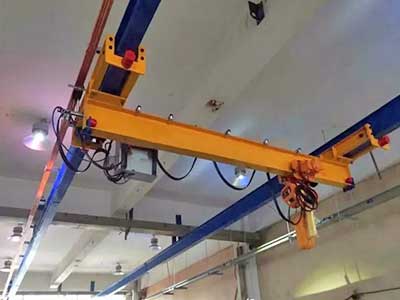
Benefits of Small Electric Cranes:
- Efficiency: Small electric cranes leverage electrical power for smooth, precise, and efficient operations. They offer consistent performance in lifting tasks with minimal energy wastage.
- Environmental Benefits: These cranes are eco-friendly, producing no emissions during operation. They contribute to a cleaner and greener working environment by reducing carbon footprint compared to conventional fuel-powered cranes.
- Reduced Operating Costs: Electric cranes often have lower operational costs due to efficient energy usage, reduced maintenance requirements, and a longer lifespan compared to traditional cranes.
- Adaptability: Small electric cranes are versatile, suitable for various industries like manufacturing, warehouses, and construction sites. They can be used indoors or in enclosed spaces due to their emission-free operation.
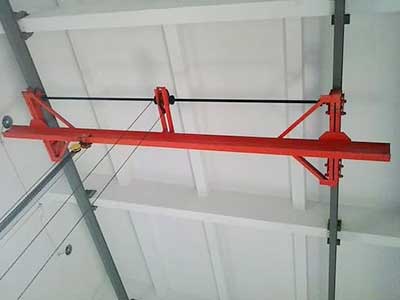
Practicality and Applications:
Flexibility: Small manual cranes offer flexibility in different work environments where power sources might be limited or inaccessible. They don't rely on electricity or fuel, providing operational independence.
- Ease of Use: These cranes are straightforward to operate and maintain. They offer a cost-effective solution for lifting lighter loads in settings where powered cranes might not be feasible.
- Versatility: Small manual cranes find applications in small-scale workshops, DIY projects, or areas with limited space, offering a portable and adaptable lifting solution.
- Cost-Effective: They often have lower initial costs compared to electric or hydraulic cranes, making them an economical choice for small-scale lifting needs.
- Accessibility: Small manual cranes can be used in various locations without the need for specific power sources or setups. They are particularly suitable for remote locations or temporary job sites.
Both Small Electric Cranes and Small Manual Cranes offer unique advantages catering to different operational needs. The electric variants emphasize efficiency, reduced environmental impact, and consistent performance, while manual cranes focus on flexibility, cost-effectiveness, and ease of use in various settings. Choosing between them depends on the specific requirements, available resources, and intended applications.
Specific Small Crane Types
Small Space Crane:
Small Space Cranes are engineered with a focus on efficiency within confined areas where maneuverability and precision are paramount. These cranes boast a compact design tailored explicitly for operations in restricted or congested spaces. Their adaptability enables them to navigate through tight corners and perform lifting tasks seamlessly where larger cranes cannot operate. Small Space Cranes find their forte in indoor environments like manufacturing plants, warehouses, and workshops, offering optimal solutions for intricate lifting requirements in limited spaces.
- Features: Compact Design: Small Space Cranes are specifically designed to operate efficiently in confined or limited spaces. Their compact structure and maneuverability allow them to navigate and perform lifting tasks in tight areas.
- Benefits: Versatility: These cranes offer the ability to operate where larger cranes may not fit or maneuver, making them suitable for indoor construction projects, workshops, or areas with space constraints.
- Applications: Indoor Operations: Small Space Cranes find application in indoor settings, such as warehouses, factories, and manufacturing plants, where space is limited, and precise lifting is required.
Small Size Crane:
Small Size Cranes embody the perfect blend of mobility and lifting power packed into a compact structure. Designed to offer adequate lifting capabilities while maintaining a smaller footprint, these cranes ensure efficient transportation and setup compared to their larger counterparts. Their versatility allows deployment in various locations, making them ideal for tasks demanding moderate lifting capacities within confined or challenging spaces. Construction sites, maintenance tasks, and temporary job sites often benefit from the convenience and adaptability these cranes provide.
- Features: Adaptability: Small Size Cranes are designed to offer both mobility and lifting power within a compact size. They provide adequate lifting capabilities while maintaining a small footprint.
- Benefits: Maneuverability: Their smaller size enables easier transportation and setup compared to larger cranes. They can be deployed quickly and efficiently in various locations.
- Applications: Versatile Lifting: These cranes are well-suited for diverse applications, such as construction sites, maintenance tasks, or temporary job sites that require moderate lifting capacities in limited spaces.
Small Site Crane:
Small Site Cranes are the workhorses of construction zones, built robustly to withstand demanding conditions and rugged environments encountered on job sites. Their sturdy construction offers stability and durability while ensuring enhanced mobility for efficient material handling and lifting within the project area. These cranes are adept at navigating through construction sites, offering the necessary lifting capabilities for building materials, equipment, and components. Their presence proves invaluable, especially in areas where larger cranes might be impractical due to space constraints or limited access.
- Features: Robust Construction: Small Site Cranes are built to withstand rugged environments and demanding conditions often encountered on construction sites. They offer stability and durability for on-site lifting tasks.
- Benefits: Enhanced Mobility: They are designed to be easily transported and positioned on construction sites, allowing for efficient material handling and lifting within the project area.
- Applications: Construction Projects: Small Site Cranes are predominantly used on construction sites for lifting building materials, equipment, and components. They prove valuable in areas where larger cranes may not have easy access or are impractical due to space limitations.
Each of these specific small crane types is tailored to address unique challenges, offering practical solutions for lifting tasks in constrained spaces or specific operational environments. Their compact designs and targeted functionalities make them invaluable tools in various industries requiring precision lifting in limited areas or specific job sites.
Similarities:
- Compact Design: All three cranes feature a compact design optimized for operations in limited or congested spaces, allowing them to navigate through tight areas efficiently.
- Versatility: Each crane type offers versatility in its own right, capable of performing lifting tasks in confined environments where larger cranes might struggle to operate effectively.
- Maneuverability: They share the attribute of enhanced maneuverability, facilitating easy transportation and positioning within specific job sites or restricted spaces.
Differences:
Focus on Space Constraints:
- Small Space Crane: Specifically engineered for tasks in confined indoor spaces where precision and limited space are critical factors.
- Small Size Crane: Offers a balance between lifting power and compactness, suitable for moderate lifting tasks in diverse locations.
- Small Site Crane: Primarily designed for construction sites, providing robustness and stability for heavy-duty lifting in challenging on-site conditions.
Primary Applications:
- Small Space Crane: Suited for indoor environments such as warehouses, workshops, or manufacturing plants where space is a significant constraint.
- Small Size Crane: Finds application in construction, maintenance, and temporary job sites requiring moderate lifting capacities.
- Small Site Crane: Predominantly used on construction sites for heavy lifting and material handling tasks.
Build and Construction:
- Small Space Crane: Built for precise, intricate lifting, focusing on maneuverability and precision.
- Small Size Crane: Balances lifting capabilities with compact design for versatile applications.
- Small Site Crane: Robustly constructed for durability and stability in rugged on-site conditions.
Operational Environment:
- Small Space Crane: Primarily operates indoors within confined spaces.
- Small Size Crane: Adaptable for various indoor and outdoor locations, offering mobility and lifting power.
- Small Site Crane: Specifically designed for construction environments, capable of handling heavy loads and challenging conditions.
While these cranes share certain characteristics like compactness and maneuverability, their differences lie in their specific design focus, primary applications, construction, and intended operational environments, allowing them to address diverse lifting needs within restricted or challenging spaces.
Hoists and Lifting Equipment
Small cranes and lifting equipment are not just about sheer power but also about efficiency and adaptability in various work settings. The Compact Power category highlights the versatility and efficiency of smaller lifting equipment:
- Small Lifting Hoist -Small Lifting Hoists are marvels of compact engineering, providing fundamental lifting capabilities within a small design. These hoists are tailored for applications where space is limited but lifting requirements are essential. They prove invaluable in scenarios where precision lifting or maneuverability within confined spaces is necessary.
- Mobile Versatility -Small Lifting Cranes on Wheels offer enhanced mobility and adaptability, allowing them to navigate through diverse work environments. These mobile cranes provide an efficient solution for lifting tasks in different locations. Their portability and ease of movement make them ideal for scenarios where lifting needs vary across multiple work areas.
- Lateral Movement -Small Hoist Trolleys are designed to enhance mobility in material handling by offering lateral movement capabilities. They facilitate lateral or side-to-side motion when lifting and transporting loads. These trolleys are particularly useful in assembly lines, workshops, or areas where precise positioning of loads is required.
- Comprehensive Solutions -Small Hoist Cranes amalgamate the advantages of both hoists and cranes, providing comprehensive lifting solutions. They combine the lifting capabilities of traditional hoists with the mobility and adaptability of cranes. These integrated solutions are versatile, offering an array of functionalities suited for varied lifting tasks across different work environments.
Each of these equipment types under Compact Power caters to specific lifting needs, whether it's about essential lifting in limited spaces, mobility across different work areas, lateral movement for precise positioning, or comprehensive solutions combining hoisting and crane functionalities. These options showcase the adaptability and efficiency of smaller lifting equipment in diverse work scenarios.
Small Crane Services: Enhancing Crane Performance and Efficiency
Small Crane Services play a crucial role in ensuring the optimal functioning and longevity of these vital lifting machines. They encompass a spectrum of support options, ranging from maintenance, repair, and consultation to comprehensive accessory exploration, all aimed at enhancing crane performance and efficiency.
- Professional Support: Ensuring Crane Reliability -Professional small crane services specialize in providing expert maintenance, repair, and consultation services tailored to enhance crane performance. These services involve routine inspections, preventive maintenance, and prompt repairs to address any operational issues. They also offer expert advice and consultations to optimize crane usage and improve efficiency, ensuring smooth operations and extending the crane's lifespan.
- Timely Support: Minimizing Downtime -Timely support is critical for minimizing downtime and ensuring prompt resolution of any operational concerns. Locating small crane services near your operational area provides immediate access to expert technicians and support staff. This proximity significantly reduces response times for maintenance and repairs, effectively reducing downtime and maximizing crane uptime for uninterrupted operations.
- Comprehensive Accessories: Augmenting Crane Functionality -Exploring a comprehensive range of lifting accessories and equipment tailored for small cranes enhances their versatility and functionality. These accessories complement the crane's capabilities, offering specialized attachments, lifting aids, and safety devices. They are designed to optimize various lifting operations, ensuring efficiency, safety, and adaptability across diverse work scenarios.
Small Crane Services serve as a backbone for maintaining, optimizing, and expanding the capabilities of small cranes. From professional support to timely maintenance, understanding pricing factors, and exploring complementary accessories, these services are instrumental in maximizing the operational efficiency and lifespan of small cranes across different industries and applications.
Informed Decisions: Small Crane Pricing Factors
Understanding the factors influencing small crane pricing is essential for making informed decisions aligned with budget considerations. Factors such as crane specifications, additional features, maintenance costs, operational expenses, and service agreements significantly impact overall pricing. This understanding empowers decision-makers to evaluate costs effectively and select options that meet both operational requirements and budget constraints.
Small Crane Pricing Factors: Key Considerations
- Crane Specifications: Load capacity, lifting height, and specialized functionalities impact costs.
- Additional Features: Advanced technologies like remote control and safety enhancements affect pricing.
- Maintenance Costs: Regular servicing and upkeep contribute to overall lifetime expenses.
- Operational Expenses: Efficiency and technological advancements influence ongoing operational costs.
- Service Agreements: Warranties and comprehensive service packages affect upfront costs and maintenance coverage.
These factors is crucial for making informed decisions while considering the operational needs and budget constraints associated with small crane procurement.
Understanding the intricacies of Small Crane Pricing Factors is fundamental when making purchasing decisions. Each factor impacts overall costs and should be carefully weighed against operational needs and budget considerations. Striking the right balance between features, maintenance, and upfront expenses ensures a cost-effective and suitable crane investment.
Contact Us:For further inquiries or expert guidance on small crane selection tailored to your specific needs, don't hesitate to reach out to our dedicated team:
Main Projects
Related Products

Supplied three grab bucket crane kits to Indonesia, enhancing garbage handling efficiency with high load capacity and reliable performance.
Free consultation to Confirm Parameters & Specifications and Get
Latest Crane Price & Crane Rate.
- Types of overhead cranes : _______?
- Optional: Overhead travelling crane, goliath gantry crane,Slewing jib crane, Single girder or double girder crane,small portable crane or kbk crane, etc.
- Capacity of overhead crane: _______?
- Optional: 0.25ton, 0.5 ton, 1 ton, 2 ton, 3ton, 5 ton, 10 ton,15ton, 20ton, 25 ton, 30ton,35ton, up to 550ton, etc.
- Crane span & lifting height : _______?
- Crane travelling length : _____?
- Control of overhead crane:_______?
- Optional: pendant/ remote/cabin control
- Voltage supply of overhead crane:_____?
- Eg,: 380V50/60HZ,3Phase or others,etc.
- Application/usage of crane:_______?
- Eg,: Steel mill, ,injection mold, cement,stone, concrete,granite, general manufacturing, etc.
Just leave a message via the contact form and our hoist and crane engineer will contact you with in 24working hours.
Get In Touch
